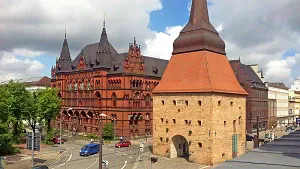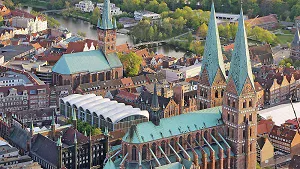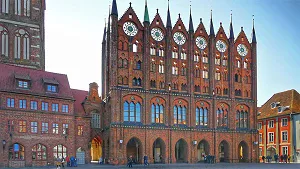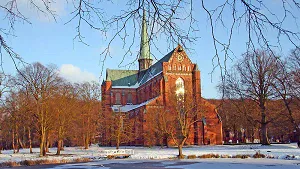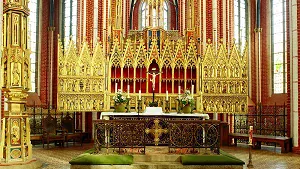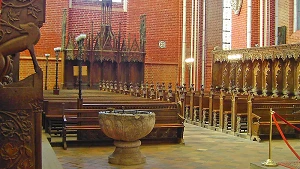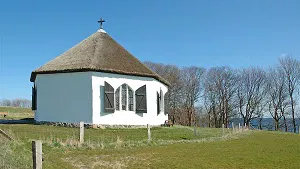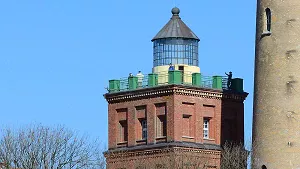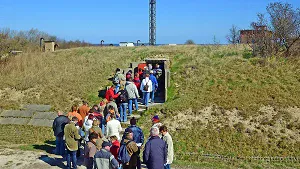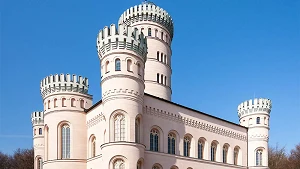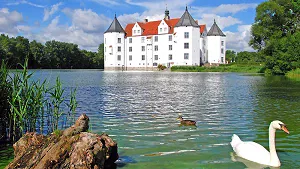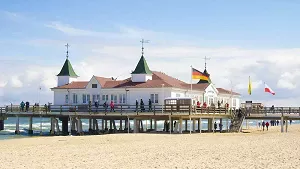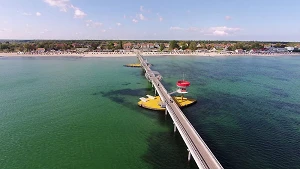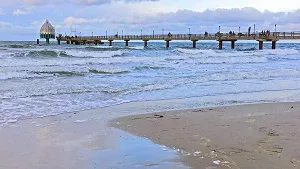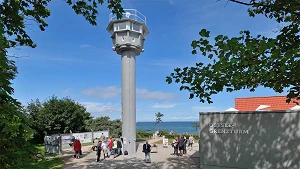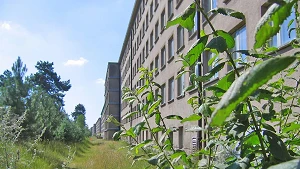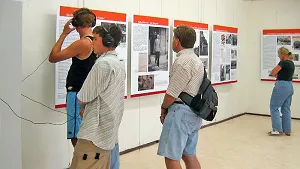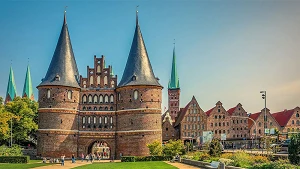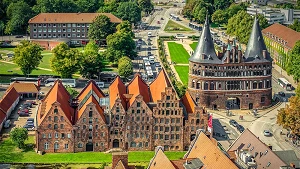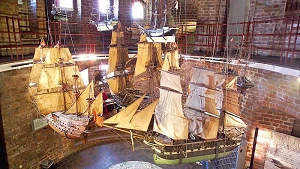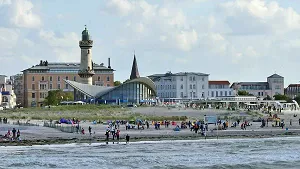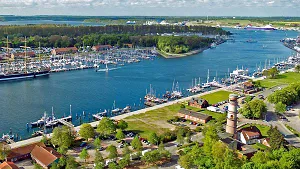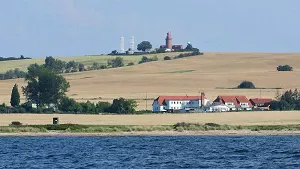Gesehen auf https://www.ostsee.de/baltic-sea-germany/sights-buildings-architecture.php am 07.05.2024
Buildings and architectural sights
Red Brick architecture – history of Red Brick Gothic
In northern Europe red bricks were first used as a building material in the 12th century and quickly got spread across the north of Germany and the Baltic.
It was used through the different eras of Red Brick architecture. Guests will find Gothic, Romanesque
and Renaissance examples going up to the 16th century. Some magnificent buildings have survived
throughout the centuries like the town hall and Steintor (constructed between 1270 and 1290)
in Rostock, church St. Marien Kirche in Stralsund (1298), church Heiligen Geist Kirche in Wismar
(first mentioned in 1255), Nikolai church in Kiel (1242), Holsten Gate in Luebeck (1464-1478) or
the Neo-gothic Red Brick building the "Staendehaus" in Rostock (built 1889-1893).
Perhaps you can be tempted to climb the steps to the viewing platforms of some of the old Red Brick
churches. Take in stunning views across the old towns of the cities.
Doberan Minster
Visitors will find Doberan Minster on the "European Route of Red Brick Architecture", in the north east of Germany, close to the old Hanseatic city of Rostock. The cathedral belonging to a former Cistercian Monastery was inaugurated in 1368. It is a marvellous example of medieval Red Brick architecture in North Germany. Fortunately it survived wars and other turmoil. All across Europe this church of a Cistercian Monastery boasts an extensive and the best kept interior.
The wooden altar is known to originate from a wood carver in Luebeck. It is one of the oldest winged
altars in Germany whose middle shrine served for the safekeeping of relics.
The 1285 erected monastery wall surrounds the former monastery and the old gate West Tor greets all guests.
Take a stroll through the stunning monastery park and gardens, learn more about the remarkable insides
on guided tours, take part in services and concerts or visit exhibitions.
Chapel in Vitt
Come and visit the octagonal chapel just outside and above the village of Vitt on the island of Ruegen. It is Germany's most northern chapel and was inaugurated in 1816.
The chapel was constructed based on plans by architect Karl Friedrich Schinkel.
Regarding written records of the Danish historian Saxo Grammticus, Vitt being a port and trading centre,
was part of the Slavonic fortress Arkona in the 10th century.
In those days religious wedding ceremonies were hold outdoors. Nowadays many newlyweds highlight their
wedding with a service in the chapel of the Schinkel lighthouse after their ceremony at a registry office.
Bunker Cape Arkona
Due to its excellent position Cape Arkona was used for military purposes. Therefore it hardly is surprising that two lighthouses are side by side two military bunkers. The latter ones are set in an area of around 2,000 square metres.
The smaller of the bunkers "Arkona-Bunker" originates from the German Armed Forces from 1935-1945
(Wehrmacht). During GDR times it was home to the 6th brigade of the National Army, called "Kueste".
Today it is an art gallery.
The bigger of the two bunkers is the so-called "NVA- Bunker". It was built in GDR times, between 1979
and 1986 and served both the Navy and the Baltic fleet (VOF) as a command post. On the
3rd October 1990, the German Unification Day, the bunker was put out of service.
Today the NVA-bunker hosts the exhibition "History of the 6th fleet and Navy of the GDR". Original
bunker interior as well as photo documentation about the Navy awaits the visitors on guided tours.
Museum Hunting Lodge Gelbensande
This building, originally planned as a summer residence, was constructed in 1885. It was built based on the plans of the architect Gotthilf Ludwig Moeckel.
Today it is home to a museum. Some of the 12 presented rooms are decorated and furnished in original
style. For example visitors are shown beautiful old fireplaces, the Duke's bathroom and technical
domestic equipment.
In exhibitions guest can learn about the history of the hunting lodge and its former residents.
Hunting Lodge Granitz
The Hunting Lodge Granitz towers on the 106 metre tall hill Tempelberg. It is embedded in extended beech woods of the Granitz on the island of Ruegen.
The Lodge in classicist style, a converted small hunting hut, was built on the account of Prince Malte
of Putbus from 1836 onwards. Visit the Red Brick building and its 38 metre tall middle tower.
144 metres above the ground, on top of the tower, visitors can enjoy fantastic panoramic views
across the island of Ruegen and parts of the mainland.
While at the Lodge visit the princely rooms and the collection "Wild Deer" which is unique to Europe.
Gluecksburg castle
Majestic like a fairy tale castle emerges Gluecksburg Castle out of the water.
Duke Johann the younger of Schleswig-Holstein-Sonderburg constructed it between 1582 and 1587. It
was built on the grounds of the former monastery Ruede.
Today it is one of the most important castle complexes in Europe. Gluecksburg Castle has been open to
the public since 1925. Most of the Renaissance interior survived.
Gluecksburg sometimes is regarded the cradle of European Royal dynasties as Johann the younger had
22 children. Their heirs married into royal families of England, Denmark, Sweden, Norway, Greece
and Russia.
Piers
Piers are a sight of many seaside resorts along the German Baltic Coast. They invite visitors to walk far into the Sea and attract thousands of guests every year, all year round.
The pier in Ahlbeck is the oldest in Germany and the one in Heringsdorf is with a length of 500 metres the longest of Continental Europe. Both are situated on the island of Usedom. On some piers, like the one in Heringsdorf, shops, cafés and a small seashell museum invite to stroll, linger and take a break. On the other hand, the pier in Sellin, on the island of Ruegen, fascinates with its towers, domes and restaurants. Many piers also serve as landing places for passenger ships that take you to other seaside resorts or on a mini cruise on the Baltic Sea.
Watchtower in Kuehlungsborn
The watchtower in Kuehlungsborn was part of the border protection system set up and used in GDR times. The tower was constructed in 1972 and declared an historical landmark in 1991. Originally there were 27 watch towers on the east coast of the Baltic Sea in Germany. This is one of the last remaining.
From a height of 15 metres, soldiers guarding the borders to neighbouring countries were searching an
area of around 12 sea miles for fugitives. They observed the sea and beaches for any movements and
anything unusual, recorded and reported them. At night time bright spotlights supported their search.
Although the climb up to the top of the tower is exhausting, you will be rewarded with striking views
across the beaches and Baltic Sea up to the horizon. Taking a historical guided tour, visitors will
learn more about the methods and equipment used to guard the borders in GDR times. An exhibition
provides background knowledge and has documentation of various attempts to escape: by rubber dinghy,
air bed or in a self-made submarine. However, most of them had a dramatic ending.
"Strength through Joy" (KdF) in Prora
The vast site, designed to accommodate 20,000 visitors at a time, was part of the Nazis' "Strength through Joy" ("Kraft durch Freude", KdF) programme. It is situated in Prora, not far from the seaside resort of Binz. Covering a length of 4.5 kilometres, eight identical blocks of buildings were constructed on the white sandy beach of Prorer Wiek from 1936 onwards. However, the six-storey houses and adjoining communal facilities were not completed when World War II began. During the war some of the buildings were used as a military hospital and accommodation for refugees. From 1948 the Red Army used it as their barracks and later the "Kasernierte Volkspolizei" (predecessor of the "National People's Army", short NVA) moved in. Parts of the area were closed off to the public and declared prohibited areas.
Today the "Koloss of Prora", the longest building of its kind in Europe, is a listed building. No
investor could be found to purchase the whole complex. Therefore, beginning in 1992, the camp was
sold in parts. Some of the houses were temporarily used as museums, galleries, gastronomic facilities
and a youth hostel.
The foundation "Neue Kultur" has been running the "Documentation Centre Prora" since 2000. One
permanent and various temporary exhibitions await the visitors here. In 2007 an international youth
camp site with 250 pitches opened its doors. Prora also features one of the biggest rope courses in
Germany. Guests will find it in the woods adjoining the KdF. It opened in spring 2008 and covers an
area of nearly 10 acres.
Holsten Gate Luebeck
The Holsten gate Luebeck was part of the fortification of the city and was formerly the Middle Holsten Gate. In 1464 the city's architect, Hinrich Helmstede, began building works as part of an overall modernisation of the entire gate construction, which was completed in 1478.
It was very nearly demolished in 1863. A decision was made only when the Lübeck citizens decided by
a majority of just one vote not to demolish the building but to instead extensively restore it. Today it
is probably the best known city gate of the whole of Germany.
The silhouette of the Holsten Gate is well known far beyond the boundaries of the country and Luebeck's
landmark. The German Cities Council (Deutscher Städte Tag) chose it as its symbol. Some of Luebeck's
companies, like a marzipan producer, use it as a trademark.
A picture of he Holsten Gate appears on a number of stamps. It was also featured on 50 DM bank notes
produced from 1958 to 1991, is featured on the 100 Euro coin of Honour of 2007 and
on the German 2 Euro coin being issued since 2006.
Today the Holsten Gate serves as a museum for municipal history. Visitors will learn about the Hanse,
trade, seafaring and commercial shipping, the history of the Holsten Gate, its arms and medieval torture
instruments.
Lighthouses
Lighthouses are used to navigate ships safely into harbours and mark dangerous coastlines, inlets, shoals and reefs. Germany's oldest lighthouse can be found in Travemuende. It is no longer in working order but is home to a museum.
Visitors can climb its steps to the top and take in the marvellous view across the Baltic Sea. This is not the only lighthouse were special offers await the guests and the top being open to the public. For example on the lighthouse in Dahmeshoeved on Dahmer Cliff, near the seaside resort of Dahme, you can get married 30 metres above the ground. The lighthouse in Bastorf, not far from the seaside resort of Kuehlungsborn, features one of the highest beacons along the Baltic coast in Germany. The one in Warnemuende offers two viewing platforms, one in 14 and the other one at a height of 25 metres and on Cape Arkona visitors will even find two lighthouses side by side.
(no responsibility is taken for the correctness of this information)
